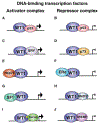Mechanisms of transcriptional regulation by WT1 (Wilms' tumour 1)
- PMID: 24927120
- PMCID: PMC8887836
- DOI: 10.1042/BJ20131587
Mechanisms of transcriptional regulation by WT1 (Wilms' tumour 1)
Abstract
The WT1 (Wilms' tumour 1) gene encodes a zinc finger transcription factor and RNA-binding protein that direct the development of several organs and tissues. WT1 manifests both tumour suppressor and oncogenic activities, but the reasons behind these opposing functions are still not clear. As a transcriptional regulator, WT1 can either activate or repress numerous target genes resulting in disparate biological effects such as growth, differentiation and apoptosis. The complex nature of WT1 is exemplified by a plethora of isoforms, post-translational modifications and multiple binding partners. How WT1 achieves specificity to regulate a large number of target genes involved in diverse physiological processes is the focus of the present review. We discuss the wealth of the growing molecular information that defines our current understanding of the versatility and utility of WT1 as a master regulator of organ development, a tumour suppressor and an oncogene.
Figures



References
-
- Kreidberg JA, Sariola H, Loring JM, Maeda M, Pelletier J, Housman D and Jaenisch R (1993) WT-1 is required for early kidney development. Cell 74, 679–691 - PubMed
-
- Moore AW, McInnes L, Kreidberg J, Hastie ND and Schedl A (1999) YAC complementation shows a requirement for Wt1 in the development of epicardium, adrenal gland and throughout nephrogenesis. Development 126, 1845–1857 - PubMed
-
- Herzer U, Crocoll A, Barton D, Howells N and Englert C (1999) The Wilms tumor suppressor gene Wt1 is required for development of the spleen. Curr. Biol 9, 837–840 - PubMed
-
- Wagner N, Wagner KD, Hammes A, Kirschner KM, Vidal VP, Schedl A and Scholz H (2005) A splice variant of the Wilms’ tumour suppressor Wt1 is required for normal development of the olfactory system. Development 132, 1327–1336 - PubMed
Publication types
MeSH terms
Substances
Grants and funding
LinkOut - more resources
Full Text Sources
Other Literature Sources
Molecular Biology Databases
Research Materials

